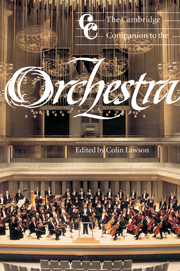Book contents
- Frontmatter
- 1 The history of the orchestra
- 2 The development of musical instruments: national trends and musical implications
- 3 The orchestral repertory
- 4 From notation to sound
- 5 The art of orchestration
- 6 The history of direction and conducting
- 7 International case studies
- 8 The revival of historical instruments
- 9 Recording the orchestra
- 10 Training the orchestral musician
- 11 The life of an orchestral musician
- 12 Historical recordings of orchestras
- 13 The orchestral composer
- 14 Educational programmes
- 15 The future of the orchestra
- Notes
- Appendices
4 - From notation to sound
Published online by Cambridge University Press: 28 September 2011
- Frontmatter
- 1 The history of the orchestra
- 2 The development of musical instruments: national trends and musical implications
- 3 The orchestral repertory
- 4 From notation to sound
- 5 The art of orchestration
- 6 The history of direction and conducting
- 7 International case studies
- 8 The revival of historical instruments
- 9 Recording the orchestra
- 10 Training the orchestral musician
- 11 The life of an orchestral musician
- 12 Historical recordings of orchestras
- 13 The orchestral composer
- 14 Educational programmes
- 15 The future of the orchestra
- Notes
- Appendices
Summary
Introduction
Why does one try to ‘read a score’, and what does it mean to do so? Conductors have two main reasons for undertaking this activity. The first is that the written or printed score is the key to understanding what happens in the music. As a conductor's principal task is to rehearse the music for performance, knowledge of the forces involved, the style, structure, and main features of the piece are vital in planning the various practical tasks that make up the rehearsal.
The second is to find out in detail what the piece sounds like, creating an aural image – ‘hearing the music in one's head’ – so that the conductor knows in advance what sounds the orchestra should make and, more specifically, the required details of balance, articulation, rhythm, tempo, and so on that distinguish a performance from a mere play-through of the notes. Some conductors go through this process of auralising the score entirely from the musical notation, while others use the piano to create the actual sound of the melodic and harmonic content of the piece.
Composers undertake this second process in reverse, trying to put on paper instructions for recreating the sounds that they have imagined. Some composers, too, use the piano in this process, generating ideas and fixing the main outlines of harmonic and rhythmic content in their minds. For the great majority, whose main active interest is in listening to orchestral music rather than creating or recreating it, the reasons for learning to read a score are less ambitious but more varied.
- Type
- Chapter
- Information
- The Cambridge Companion to the Orchestra , pp. 71 - 91Publisher: Cambridge University PressPrint publication year: 2003



